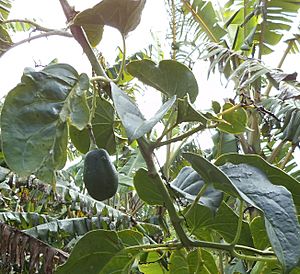Solanum sibundoyense facts for kids
Solanum sibundoyense is a special kind of plant that belongs to the nightshade family. It's a small tree that grows only in Colombia, a country in South America. You can find it mostly in cloud forests, which are high-up forests often covered in mist. People in Colombia sometimes call it "tomate salvaje" or "tomate silvestre," which means "wild tomato." This plant is found in areas like Sibundoy and nearby places, growing at heights between 1,400 and 2,300 meters (about 4,600 to 7,500 feet) above sea level.
Quick facts for kids Solanum sibundoyense |
|
|---|---|
 |
|
| The immature fruit and leaves of Solanum sibundoyense | |
| Conservation status | |
| Scientific classification | |
| Genus: |
Solanum
|
| Species: |
sibundoyense
|
What it Looks Like
Solanum sibundoyense is a small tree. It usually grows to be about 4 to 8 meters (13 to 26 feet) tall. Its stems are mostly smooth. Sometimes, they have a few tiny hairs that are less than half a millimeter long.
What are its Uses?
The fruits of Solanum sibundoyense are safe to eat. They have a pleasant, slightly sour taste. This plant produces some of the biggest fruits in its group. The soft part inside the fruit around the seeds is often purple.
Some of these fruits are sweet and juicy. Others are more sour and not sweet at all. The fruits ripen slowly. Once they are ripe, they stay fresh longer than a tamarillo fruit.
Historically, people in the Sibundoy Valley in southern Colombia used the fruit. They made black, blue, or yellow dyes from it. Some traditional sources also suggest that parts of the fruit might be used to help with tummy troubles. The Kamsá people of the Sibundoy Valley, for example, used a special liquid made from the leaves for this purpose.


